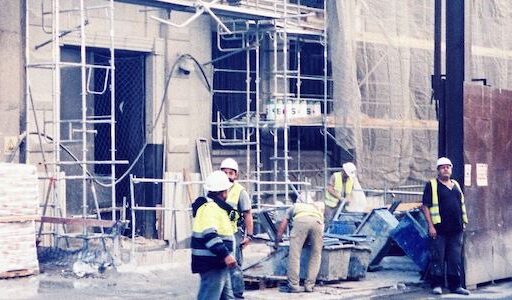Dashpivot article – Construction Phase Plan Examples
Construction Phase Plan Examples
In this article, common examples of a Construction Phase Plan (CPP) will be discussed, highlighting their important components, how each of the examples differ from one another, and how each structure of a CPP can be changed depending on the type of construction project.

Covered as well will be basic components and the best practices to implement a highly effective CPP for any type of project. The construction industry has already been shifting to utilising digital tools and leveraging their features to streamline the CPP process as digital tools and software make it easier to create, update, and even share CPPs across key persons involved like owners, clients, managers, workers, and safety personnel. We’ll see how each feature can cater to designing a CPP based on the type of construction project.
What is a Construction Phase Plan (CPP)?
A Construction Phase Plan (CPP) is a dynamic document, mandated under the Construction (Design and Management) Regulations 2015 (CDM 2015), that is drafted prior to starting a construction project. It ensures that projects outline the potential hazards recognisable from the construction plans, common patterns, and work to be done. The CPP also outlines the risk assessments and safety procedures to be executed, helping contractors, workers, and safety personnel comply with safety regulations and maintain a safey workplace once actual work starts. Being a dynamic document means that it needs to be continuously updated as more risks are recognised during the project. Construction plans may change, and the field and workplace may also undergo multiple changes, which will likely introduce hazards that werent identified prior to starting. Regular reviews and revisions of the CPP are important, to effectively make sure that the safety procedures and relevant. Having a proper documentation proocedure for the updates ensures that all key personnal remain involed and compliance with the latest safety protocols.
What are the Key Components of any good example CPP?
The key components of a CPP include a Project Overview, Roles and Responsibilities, Risk Assessment/Hazard Identification and Control Measures, Site Rules, Induction and Training, Safe Handing of Materials and Equipment Maintenance, Emergency Response Section, and Monitoring Section. The contents may vary depending on the nature, scale, and complexity of the construction project. Smaller projects may contain straightforward sections in their CPP, only focusing on the fundamental safety procedures and risk management. Other sections may still be included but only with minimal information due to few workers, or few areas for evacuation plans. Larger projects, on the other hand, require a much more comprehensive CPP and documentation. The training sections include protocols for high-risk activities, the site rules highlight multi-contractor coordination, and an even more comprehensive emergecy response procedure and planning for the different areas in the project.
Project Overview
The project overview simply displays the project name, its location, and brief description. If necessary, the client, principal contractor, a list of subcontractors will be laid out, including the project timeline and its key milestones. This section is pretty straightforward. It provides the most basic but essential details about the project.
Roles and Responsibilities of Key Persons in Health and Safety Management
This section of the CPP outlines how each key persons involved can promote a safe workplace within their job roles and responsibilities, and how safety will be managed as an organisation on-site. Each key personnel like the principal contractor, site managers, safety personnel, and first aid responders will be included on the list along with their contact details.
This section also details how safey information should be dessimated among workers and contractors, like through safety meetings, toolbox talks, and other similar modes of communication. This also outlines the procedures for reporting hazards, near-misses, and incidents.
Risk Assessment/Hazard Identification and Control Measures
The risk assessment and hazard identification section of the CPP is one of the most crucial parts because the key persons responsibile for outlining the CPP should recognise the possible hazards and risks involved prior construction works. These include working at heights, elevations, underground, or confined spaces, excavations, using heavy machinery, manual handling, fire hazards, electrical hazards, and even handling hazardous substances.
The risk assessment process includes using a Risk Matrix, or a Likelihood and Severity Analysis that helps safety personnel evaluate the likelihood and severity of each hazard or risk identified. It’s better to utilise a table where the safety personnel can add entries for each hazard. The categorisation would then base depending on the type of information the organisation needs, like maybe grouping hazards found in the same area, or grouping hazards based on a work activity. Using the Risk Matrix, safety personnel will then assess each identified hazard, mark their likelihood and severity, and categorise these risks as either Low, Medium, or High. Knowing which risk category these are can help organisations prioritise which ones should be mitigated as soon as possible. An additional column indicating the control measures as suggested by the safety personnel is also included.
To ensure that the control measures are effective and helpful, a risk assessment is performed again as a form of monitoring process to check and see the likelihood and severty of the risk happening again with the safey procedures in place.
Site Rules and Procedures
This section of the CPP establishes proper and clear guidelines of the general site rules that apply to all personnel on the site, for example, access control. Written in the CPP should include where there should be clear signages and displayed writings that only authorised individuals or personnel are allowed on the site, or anyone who isn’t typically permitted to enter need to log in their details at the entrace and wear the appropriate PPE. Another would be indicating a general rule that all workers are to wear the required PPE anywhere on the site. Some of the common general rules also include proper work area housekeeping and not permitting work to unauthorised individuals.
Aside from general site rules, there are also rules that cover specific construction activities. These should be outlined in the CPP and properly disseminated to anyone who will be working on them. Like for example, for lifting operations, the cranes must be operated by trained personnel, there should be a crane inspection done before operation starts, or providing clean signaling procedures. Safety personnel should always include a section that for when using tools, machinery, or equipment, there are guidelines the workers should follow.
Furthermore, the evacuation plans, exits, assembly points, emergency contact details, fire safety information, first aid, and incident reporting procedures should also be outlined in the CPP.
Induction and Training
This section of the CPP outlines the processes workers, contractors, and visitors must undergo an induction session that covers the project details, general site rules and other safety procedures, emergency plans, reporting processes, and the access points on site.
It’s also essential to outline in the CPP the necessary training programs and certifications the workers must have prior to starting work to determine that they are competent, able, and prepared.
Additionally, this section should include a table that displays the certifications, licenses, and other training to display and confirm that they are capable and trained for specific tasks. This part of the CPP assures the stakeholders and anyone involved that the workers are highly trained and trustworthy.
Safe Handling of Materials and Equipment Maintenance
This section of the CPP provides the safety procedures of handling and using materials and equipment on site, to prevent damages, accidents, and fatalities. Most especially on equipment, this also includes the pre-use inspections, scheduled maintenance, repairs, calibrations, and testing procedures.
Emergency Response
The emergency response section of a CPP outlines the emergency procedures to be able to handle the emergencies efficiently and quickly. The ultimate goal is to foster a safe working environment and minimise damages and injuries.
A proper list of key emergency contacts like the site manager, safety officer, first aid responders, and emergecy services should be displayed.
Another part of this section must also detail the emergency procedures to take in various emergency situations like fire, medical emergencies, earthquake, evacuation, chemical spills, or structural failure.
One of the most important parts of this section is including sketches or maps or locations of the fire extinguishers, alarms, first aid kids, medical stations, and more. Outlined are also their inspection and maintenance schedule to ensure that they are effective and functional.
Monitoring Section
The monitoring section makes sure that the safety measures are being consistently implemented in the workplace while work in ongoing, the risks are regularly assessed, and that everything are in compliance with standards and regulations.
Examples of Construction Phase Plan (Small, Large, and Infrastructure Projects)
Example 1: Large Commercial Construction Project
Shown below is an example of a Construction Phase plan you can use onsite:

Use this free digital Construction Phase Plan example
Optimising and Streamlining your Construction Phase Plan
As mentioned, the dynamic construction industry has opted organisations to shift to using digital tools and streamline ther CPP process making it easier to create, update, and even share CPPs across key persons involved like owners, clients, managers, workers, and safety personnel. But how do they really streamline the CPP process?
Creating, managing, and religiously updating a CPP may be complex, especially since it’s such a dynamic document and it just gets longer and longer the bigger the project. Digital tools can improve the entire workflow, reduce the tedious administrative work so you can focus more on the actual construction works, and improve communication between key personnel. The repetitive tasks every ones can be automated, which ensures that only relevant information are included in your CPP. Digital tools allow customisations and standardisations of the CPP contents and automations in risk assessments. You can so much easily adopt the best practices and design the plans to be fully aligned with health and safety regulations like the CDM 2015 and industry standards. Instead of having multiple copies and hundreds of versions stored in your desktop, digital tools allows revision management and stores all documents in the cloud. You can easily view and retrieve information with just a few simple clicks. Because data is stored in the cloud, collaboration is made easier, mobile accessibility is made possible, and data is synced in real time.
Digitising this construction phase plan has never been easier with this Construction Phase Plan App.
Whether your business is small or big, or whether you’re working on small-scale builds and renovations, or large-scale developments, having a proper and well-documented CPP that fully adjusts to the type of project and your needs assists in preventing the risks and fully-streamlines your operations.

Near Miss Reporting template
Keep site safer by making your near miss reporting procedure safe and streamlined.

Site diary template
Complete and organise your daily diaries more efficiently.

Risk Register template
A general risk register template you can use for documenting any type of project risk.


